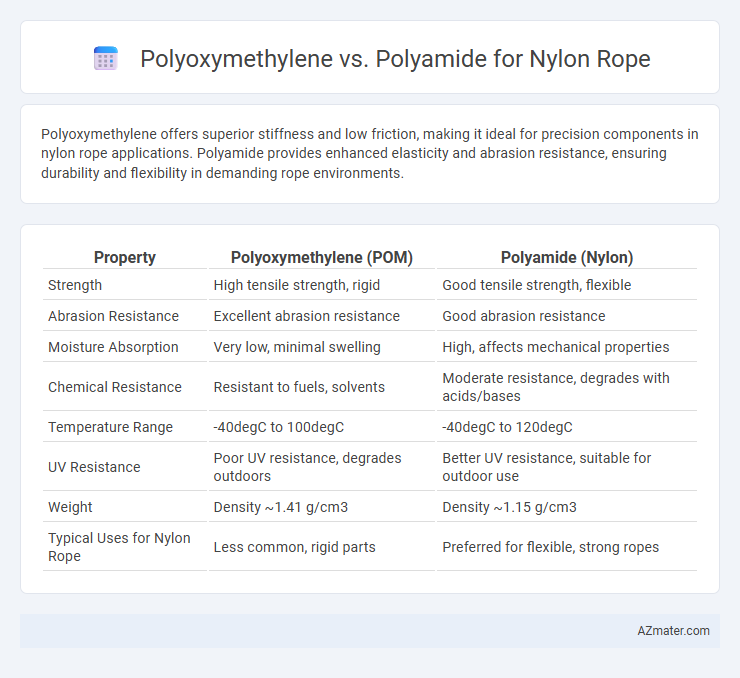Polyoxymethylene offers superior stiffness and low friction, making it ideal for precision components in nylon rope applications. Polyamide provides enhanced elasticity and abrasion resistance, ensuring durability and flexibility in demanding rope environments.
Table of Comparison
| Property | Polyoxymethylene (POM) | Polyamide (Nylon) |
|---|---|---|
| Strength | High tensile strength, rigid | Good tensile strength, flexible |
| Abrasion Resistance | Excellent abrasion resistance | Good abrasion resistance |
| Moisture Absorption | Very low, minimal swelling | High, affects mechanical properties |
| Chemical Resistance | Resistant to fuels, solvents | Moderate resistance, degrades with acids/bases |
| Temperature Range | -40degC to 100degC | -40degC to 120degC |
| UV Resistance | Poor UV resistance, degrades outdoors | Better UV resistance, suitable for outdoor use |
| Weight | Density ~1.41 g/cm3 | Density ~1.15 g/cm3 |
| Typical Uses for Nylon Rope | Less common, rigid parts | Preferred for flexible, strong ropes |
Introduction to Polyoxymethylene and Polyamide
Polyoxymethylene (POM) is a highly crystalline thermoplastic known for its exceptional stiffness, low friction, and excellent dimensional stability, making it ideal for precision components in nylon rope applications. Polyamide, commonly referred to as nylon, offers strong abrasion resistance, flexibility, and high tensile strength, which enhances the durability and performance of nylon ropes under dynamic loads. Comparing these polymers highlights POM's superior rigidity and wear resistance against polyamide's toughness and elasticity, crucial for selecting materials based on specific nylon rope requirements.
Chemical Composition and Structure Comparison
Polyoxymethylene (POM) is a semi-crystalline thermoplastic made of repeating -CH2-O- units, offering high rigidity and low friction with great chemical resistance, while Polyamide (Nylon) consists of repeating amide groups (-CONH-) that provide excellent toughness and flexibility due to hydrogen bonding. The chemical backbone of POM is an acetal polymer structure with strong C-O-C linkages, whereas Nylon's structure contains polar amide bonds facilitating water absorption and enhanced mechanical strength through intermolecular hydrogen bonds. Differences in their molecular architecture make POM ideal for dimensionally stable, low-friction applications, while Nylon ropes benefit from superior impact resistance and elasticity due to their polyamide chain arrangement.
Mechanical Properties: Strength and Durability
Polyoxymethylene (POM) offers superior tensile strength and stiffness compared to polyamide (nylon), making it highly resistant to mechanical wear and deformation under heavy loads. Nylon ropes exhibit excellent impact resistance and flexibility but tend to absorb moisture, which can reduce their mechanical strength over time. For applications demanding high durability and minimal creep under consistent stress, polyoxymethylene provides better long-term mechanical reliability than polyamide-based nylon ropes.
Resistance to Wear and Abrasion
Polyoxymethylene (POM) exhibits superior resistance to wear and abrasion compared to polyamide (Nylon) due to its high crystallinity and low coefficient of friction, making it ideal for applications requiring long-lasting durability in ropes. Polyamide, while strong and flexible, tends to absorb moisture which can reduce its abrasion resistance and lead to quicker degradation under harsh conditions. Selecting Polyoxymethylene for nylon ropes ensures enhanced performance in environments demanding consistent wear resistance and minimal material loss.
Flexibility and Elasticity in Rope Applications
Polyoxymethylene (POM) provides superior dimensional stability and low moisture absorption, making it less flexible but highly durable for precise nylon rope components. Polyamide, commonly known as nylon, offers excellent flexibility and high elasticity, essential for rope applications requiring stretch and resilience under load. The choice between POM and polyamide depends on the need for either stiffness and wear resistance or flexibility and energy absorption in nylon ropes.
Environmental Resistance: Moisture and UV Stability
Polyoxymethylene (POM) offers superior moisture resistance compared to polyamide (nylon), as it absorbs less water and maintains dimensional stability in humid conditions. Polyamide tends to degrade over time with UV exposure, leading to loss of mechanical strength and surface deterioration, whereas POM exhibits better UV stability, making it more durable for outdoor nylon rope applications. These environmental resistance properties make POM a preferred choice when moisture absorption and UV degradation are critical factors for rope longevity.
Weight and Density Differences
Polyoxymethylene (POM) typically has a density around 1.41 g/cm3, whereas polyamide (nylon) ranges from 1.13 to 1.15 g/cm3, making POM denser and generally heavier for the same volume. This higher density impacts the overall weight of ropes made from these materials, with nylon ropes being lighter and more suitable for weight-sensitive applications. Choosing between POM and polyamide for nylon rope depends on balancing strength requirements against weight constraints, where nylon offers a lighter option without compromising durability.
Cost and Availability for Rope Manufacturing
Polyoxymethylene (POM) offers a lower material cost and higher dimensional stability compared to polyamide, making it a cost-effective choice for nylon rope manufacturing. Polyamide (PA), while more expensive, boasts superior elasticity and moisture resistance, which can drive up production complexity and lead times due to supply fluctuations. Availability of polyamide is generally broader in global markets, but POM's increased demand in industrial applications can cause localized shortages affecting rope production timelines.
Common Uses: Polyoxymethylene vs Polyamide Ropes
Polyoxymethylene ropes are commonly used in applications requiring high stiffness, low friction, and excellent dimensional stability, such as precision mechanical components and rigging in marine environments. Polyamide ropes, including nylon, excel in dynamic load-bearing, shock absorption, and abrasion resistance, making them ideal for climbing, rescue operations, and heavy-duty mooring. While polyoxymethylene offers superior chemical resistance and low moisture absorption, polyamide's elasticity and strength under tension make it the preferred choice for versatile, durable nylon ropes.
Conclusion: Choosing the Right Material for Nylon Rope
Polyamide offers superior flexibility and abrasion resistance, making it ideal for dynamic nylon rope applications that demand durability and strength. Polyoxymethylene provides excellent dimensional stability and low friction, suitable for ropes requiring high stiffness and minimal stretch. Selecting the right material depends on the specific performance requirements, where polyamide excels in elasticity and wear resistance, while polyoxymethylene is preferred for rigidity and precision.

Infographic: Polyoxymethylene vs Polyamide for Nylon Rope
 azmater.com
azmater.com